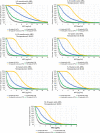Population Pharmacokinetic Modeling of Total and Free Ceftriaxone in Critically Ill Children and Young Adults and Monte Carlo Simulations Support Twice Daily Dosing for Target Attainment
- PMID: 34633847
- PMCID: PMC8765235
- DOI: 10.1128/AAC.01427-21
Population Pharmacokinetic Modeling of Total and Free Ceftriaxone in Critically Ill Children and Young Adults and Monte Carlo Simulations Support Twice Daily Dosing for Target Attainment
Abstract
Critical illness, including sepsis, causes significant pathophysiologic changes that alter the pharmacokinetics (PK) of antibiotics. Ceftriaxone is one of the most prescribed antibiotics in patients admitted to the pediatric intensive care unit (PICU). We sought to develop population PK models of both total ceftriaxone and free ceftriaxone in children admitted to a single-center PICU using a scavenged opportunistic sampling approach. We tested if the presence of sepsis and phase of illness (before or after 48 h of antibiotic treatment) altered ceftriaxone PK parameters. We performed Monte Carlo simulations to evaluate whether dosing regimens commonly used in PICUs in the United States (50 mg/kg of body weight every 12 h versus 24 h) resulted in adequate antimicrobial coverage. We found that a two-compartment model best described both total and free ceftriaxone concentrations. For free concentrations, the population clearance value is 6.54 L/h/70 kg, central volume is 25.4 L/70 kg, and peripheral volume is 19.6 L/70 kg. For both models, we found that allometric weight scaling, postmenstrual age, creatinine clearance, and daily highest temperature had significant effects on clearance. The presence of sepsis or phase of illness did not have a significant effect on clearance or volume of distribution. Monte Carlo simulations demonstrated that to achieve free concentrations above 1 μg/ml for 100% of the dosing intervals, a dosing regimen of 50 mg/kg every 12 h is recommended for most patients. A continuous infusion could be considered if the target is to maintain free concentrations four times above the MICs (4 μg/ml).
Keywords: beta-lactams; ceftriaxone; critically ill; pharmacodynamics; pharmacokinetics.
Figures




References
-
- Rhodes A, Evans LE, Alhazzani W, Levy MM, Antonelli M, Ferrer R, Kumar A, Sevransky JE, Sprung CL, Nunnally ME, Rochwerg B, Rubenfeld GD, Angus DC, Annane D, Beale RJ, Bellinghan GJ, Bernard GR, Chiche JD, Coopersmith C, De Backer DP, French CJ, Fujishima S, Gerlach H, Hidalgo JL, Hollenberg SM, Jones AE, Karnad DR, Kleinpell RM, Koh Y, Lisboa TC, Machado FR, Marini JJ, Marshall JC, Mazuski JE, McIntyre LA, McLean AS, Mehta S, Moreno RP, Myburgh J, Navalesi P, Nishida O, Osborn TM, Perner A, Plunkett CM, Ranieri M, Schorr CA, Seckel MA, Seymour CW, Shieh L, Shukri KA, et al.. 2017. Surviving sepsis campaign: international guidelines for management of sepsis and septic shock: 2016. Intensive Care Med 43:304–377. 10.1007/s00134-017-4683-6. - DOI - PubMed
-
- Weiss SL, Fitzgerald JC, Pappachan J, Wheeler D, Jaramillo-Bustamante JC, Salloo A, Singhi SC, Erickson S, Roy JA, Bush JL, Nadkarni VM, Thomas NJ, Sepsis Prevalence, Outcomes, and Therapies (SPROUT) Study Investigators and Pediatric Acute Lung Injury and Sepsis Investigators (PALISI) Network. 2015. Global epidemiology of pediatric severe sepsis: the sepsis prevalence, outcomes, and therapies study. Am J Respir Crit Care Med 191:1147–1157. 10.1164/rccm.201412-2323OC. - DOI - PMC - PubMed
Publication types
MeSH terms
Substances
Grants and funding
LinkOut - more resources
Full Text Sources

